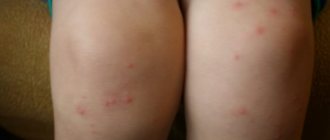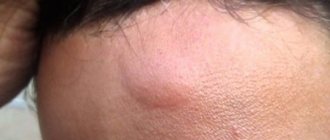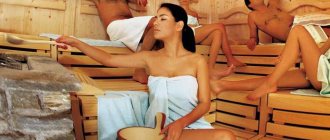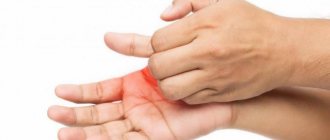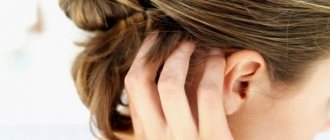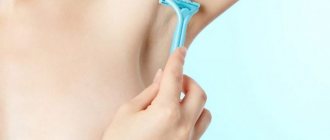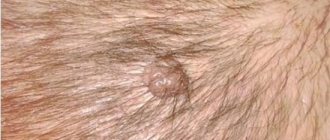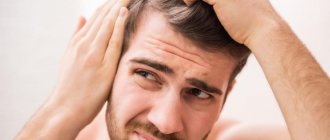Dandruff and sores on the head
Dandruff with sores are detected immediately after a visual examination; at the initial stage of development of the disease, red spots covered with scabs appear, compactions, scales, and small rashes form .
The patient experiences strong discomfort and begins to intensively scratch the affected areas, which leads to the formation of microtraumas and aggravation of the situation. Over time, the condition of the follicles deteriorates and hair may begin to fall out .
How quickly can you get rid of the problem?
How to treat the primary process that occurs with scabs on the head, and how long it will take to eliminate it, depends on the timeliness of contacting a doctor. The general condition of the body is also important.
The average recovery period takes 1-4 weeks, and sometimes more. If you start appropriate treatment with pharmaceutical and folk remedies at the initial stage, stable remission occurs. You can support your body by following the right lifestyle.
It is easier to prevent dermatological pathologies than to quickly deal with unpleasant symptoms and negative consequences. If it was not possible to avoid the development of the disease, you can quickly achieve recovery by following the doctor’s prescriptions and recommendations.
Causes
The causes of sores on the scalp can be very trivial - thermal/mechanical damage resulting from rough combing, frequent use of a hairdryer, temperature changes.
When the first signs of the disease appear, it is recommended to immediately consult a trichologist ; in some cases, the cause of the development of the disease lies in changes in the patient’s psycho-emotional state .
Sores can occur as a result of severe stress , hypothermia or a cold. In other cases, such symptoms indicate illness.
Seborrhea is a disorder of the sebum secretion of the skin, provoked by yeast-like fungi, the activation of which occurs under certain conditions:
- psoriasis;
- dermatitis of allergic origin - an acute reaction to certain components of cosmetics or medications;
- pityriasis versicolor - common among pediatric patients, transmitted through household items;
- deficiency of vitamins in the body - unbalanced diet;
- dermatophytosis.
Scabs in children
In the pediatric category of patients, scabs develop with the development of similar clinical manifestations as in adults, with the only difference that children are characterized by the development of polymorphic elements of the rash and a tendency to attach a secondary infection, which significantly aggravates the course of the underlying disease.
Scabs in infants are manifested by skin symptoms simulating urticaria, so in most cases timely diagnosis of this pathology is difficult. The favorite localization of skin elements of scab rash in infants is the skin of the buttock folds, the lateral surfaces of the torso and face. At the onset of the disease, the scab is represented by a papular and petechial rash, and with a prolonged course, the development of widespread eczematous skin lesions is noted. These skin changes are accompanied not only by itching, but also by intense pain, which causes anxiety in the child, especially in the evening and at night.
Due to the rapid progression of the disease, as well as the addition of a secondary bacterial infection, a child suffering from scabs may experience signs of lymphadenitis in the form of a significant increase in the group of regional lymphatic collectors, their soreness and hyperemia of the skin over their location. In the absence of treatment measures aimed at eliminating the scab pathogen, the child may develop signs of severe generalized sepsis, which is a life-threatening condition for the patient. Medications used to treat scabs in children can provoke the development of an allergic reaction in the form of dermatitis, therefore, when the first signs of this condition appear, parents should immediately contact their treating dermatologist in order to correct further therapy.
In a situation where the clinical picture of a scab in a child is erased or has atypical manifestations, an additional examination is indicated, consisting of a bacteriological examination of the pathogen extracted from the “intradermal tract”. This technique has a high degree of reliability and verification of the diagnosis in this situation is not difficult.
scabs on children's skin photo
Causes of scabs and dandruff on the head
- microsporia - red spots form on the skin, turning into small blisters, scabs appear at the site of their rupture, and hair falls out;
- ringworm;
- favus (scab);
- scabies - caused by scabies mite;
- allergic reactions;
- acne - with endocrine and hormonal disorders.
The clinical picture is very similar in all cases.
How to treat dandruff and scalp sores?
Shampoos
Anti-dandruff shampoos contain special detergents, the action of which is aimed at eliminating dead skin parts, as well as additives that slow down the formation of new dandruff .
Most often, they contain no fragrances, which ensures maximum softness and safety.
Currently, there are a large number of different anti-dandruff shampoos, the composition of which is different.
The presence of selenium dusulfate, zinc pyrithione, clotrimazole, and ketoconazole helps reduce the number of microbes.
Some of them are created taking into account the type of hair (oily, dry) and the type of dandruff. Ichthyol and tar normalize the process of cellular renewal; shampoos with tar are also recommended for patients with oily hair. Zinc pyrithione helps in the treatment of dandruff in patients with normal to dry hair.
- Sulsena - eliminates the cause of discomfort, can be used as a prophylactic;
- Nizoral - antifungal shampoo, effectively eliminates itching, used for seborrhea, dandruff, lichen;
- Sebozole - created on the basis of ketoconazole, effectively destroys the fungus.
Read tips on how to choose the right shampoo for a man or woman, as well as for dry or oily dandruff.
Folk remedies
Along with medicines, folk recipes are widely used; their preparation does not require complex products , all components are at hand.
The most effective is a mixture of vegetable oil and tomato juice in equal proportions . It is recommended to apply the mixture to the scalp 3 times a day; the result is noticeable after the first use.
To treat scabs, you can also use heated bread kvass , which must be applied to the scalp and washed off after 3 hours. After the procedure, you need to change bed linen and clothes.
a mixture of crushed sulfur, salt and lard to the scalp 3 times a day, treatment duration is 5 days.
Salicylic acid is also part of aspirin; this active substance has antimicrobial properties, relieves itching, and eliminates inflammation.
Two tablets must be crushed and added to shampoo; while washing your hair, the foam must be kept for at least 20 minutes.
, which has strong exfoliating properties, will help with psoriasis Dilute 4 tsp of baking soda with plain water, apply the mixture to the scalp, and rinse with cold water.
A massage with aromatic oils or salt will also help get rid of dandruff . In the latter case, a peeling effect is obtained, as a result of which it is possible to get rid of dead cells and fat, and hair growth is stimulated.
Crusts in newborns and infants
If a mother finds a crust on the newborn’s head in the first days after birth, this may be remnants of vernix (cheese-like) lubricant. The lubricant is mucus-like and, when dried, forms a thin grayish crust. Easily removed with a cotton ball moistened with warm water.
You need to clean the baby's head carefully from the center to the periphery without pressing or scratching movements. Take special care in the area of the fontanelles. The baby's head should be washed regularly. When hair changes, epithelial scales and hairs can form a dense dark crust.
“Milk crusts”, “baby cap”, “cradle cap” - all these are the names of yellowish-brown crusts that fit tightly to the baby’s scalp. As a rule, they are difficult to remove. For these purposes, it is rational to use neutral oil (corn, sunflower, olive, burdock, vaseline). The oil is applied to the scalp and causes crusts to fall off, which are then removed with baby shampoo or soap.
The medical name for “milk crusts” in newborns and infants is gneiss or seborrheic dermatitis of newborns. They appear at 1–2 months of age in most babies and are not a defect in care. Gneiss does not cause any discomfort to the child; it does not itch or hurt.
Experts associate the appearance of scabs on a baby’s head with hypersecretion of the skin glands. Pay attention to the skin behind the baby's ears. Often crusts form there and the skin peels off. Less commonly, gneiss appears on the skin under the eyebrows. The condition usually lasts from several weeks to several months and does not require treatment.
Scabs on the head are removed using oil and shampoo. Apply baby cream behind the ears. The crusts must be removed carefully so as not to damage the baby’s delicate scalp.
Seborrheic dermatitis in infants can also develop for less natural reasons:
- Long-term intake of antibiotics and associated intestinal dysbiosis.
- Gastrointestinal pathology.
- When breastfeeding, the mother consumes obligate (obligatory) allergens: honey, chocolate, alcohol.
- Hypovitaminosis of a pregnant woman and lack of PUFAs (polyunsaturated fatty acids) during pregnancy.
Gneiss in children beyond infancy is a pathology associated with defects in care and diseases of internal organs.
Duration of treatment
Treatment of dandruff and sores with shampoos may take several weeks , but the first results are noticeable within the first few days of use. If shampoos and conditioners do not help, it is recommended to contact a trichologist who will prescribe treatment.
Treatment of scabs and dandruff involves the use of medications, the use of shampoos and traditional recipes.
- esdepalletrin - quickly relieves itching and dandruff, an excellent remedy for fighting mites, which die after the first use;
- Walkinson's ointment - quickly helps with itching, rashes and redness, even eliminates dandruff, due to its high toxicity it is contraindicated for children;
- crotamiton is available in the form of a cream and emulsion, applied after a shower to cleansed skin, contraindicated for children, during pregnancy and lactation;
- spregal – available in the form of a spray, eliminates dandruff sores.
Pharmacy products for treatment
To eliminate the pathology, a specialist may prescribe hardware procedures, folk remedies or medications.
The medications most often prescribed by dermatologists are:
| Name of medicines and release form | Composition and therapeutic effect | Nuances of use | Possible side effects and contraindications |
| Sulsena (shampoo, paste, oil) | The active substance selenium disulfide has antifungal, exfoliating and restorative properties. It also normalizes the activity of the sebaceous glands. | The paste must be applied to damp, clean hair and left for 5-20 minutes. The procedures must be repeated 2-3 times a week for 1-2 months. Shampoo is used instead of detergent. It takes at least 3 minutes to lather your hair and scalp. Repeat the procedure 2 times. Use as hair becomes dirty for up to 2 months. Apply the oil to damp hair and leave for 2 hours. After this, you need to wash your hair with shampoo without additives. | The products are not used during pregnancy and breastfeeding. Therapy may be accompanied by allergic reactions and changes in hair tone. |
| Naftaderm (ointment) | The active ingredient is naftalan oil (refined). The product is used for any pathologies accompanied by the formation of crusts. The composition has disinfecting, analgesic and antipruritic effects. It also eliminates inflammation and accelerates wound healing. | The ointment must be applied to the affected skin 2 times a day (without rubbing) for 3-4 weeks. | In the presence of oncology, anemia and severe pathologies of the liver and kidneys, the drug is not used. The composition may cause dry skin and allergic reactions. |
| Salicylic ointment | The basis of the ointment is salicylic acid. Its action is aimed at disinfecting and accelerating cell regeneration. | The course of treatment with ointment is determined by a dermatologist and can range from 6 to 20 days. The frequency of application of the product is determined by the doctor. | The product should not be used if there is an allergic reaction to the components. Therapy may be accompanied by skin rashes, burning and itching. |
Cynovaite is available in the form:
| The active substance is zinc pyrithione. The drugs have antibacterial, anti-inflammatory and antifungal properties. | Shampoo is used to treat the scalp. It must be applied to damp hair and rubbed in for 1 minute. Rinse off and reapply the composition and leave for 3 minutes. The shampoo is recommended to be used 2-3 times a week for 1 month. With the permission of the doctor, it is possible to use other forms of the drug. The course is determined by a dermatologist. | Contraindications for use and side effects are allergic reactions of the body. |
| Keto plus (shampoo) | The active ingredients are ketonazole and zinc pyrithione. The composition has an antifungal effect. | The shampoo is used 2 times a week for 4 weeks. | Using shampoo may cause dryness, itching, hair loss (or change in color). |
| Shampoo 9111 | The shampoo is produced with a variety of active ingredients (onion, tar, vitamin). The compositions have restorative effects, accelerate skin regeneration and help strengthen hair. | The shampoo is used 2 times a week for a month. | The drugs have a natural composition, so an allergic reaction is a contraindication and side effects. |
If the prescribed drug does not have a therapeutic effect after use for 14 days, a replacement must be made.
Summarize
Dandruff is considered a fairly common disease, affecting approximately 20% of the world's population .
In some cases, dandruff is accompanied by the formation of sores and scabs, causing itching and other discomfort.
The reasons for their occurrence are very different, it could be lichen, psoriasis, allergic dermatitis, fungi, lack of vitamins or problems with the digestive system .
Currently, there are a large number of anti-dandruff shampoos; if you have sores, it is recommended to consult a trichologist.
The doctor prescribes treatment based on diagnosis; ointments and creams will help get rid of the disease very quickly. When fighting dandruff, you can also use folk recipes, but only after consulting a trichologist, identifying the cause of the disease and making a diagnosis.
Eczema of the scalp in adults and children
Eczema, which affects the scalp , is a dermatological disease that occurs when the sebaceous glands are too active and there is an acute lack of moisture. In addition to unpleasant sensations and damage to the skin, psychological discomfort also occurs, since it can be virtually impossible to hide the external manifestations of the disease in such a noticeable area.
Many people fail to get rid of eczema quickly and it becomes a real problem for them. This article allows you to get acquainted with the main causes leading to the occurrence of the disease, as well as its varieties and methods of treatment.
Causes of dandruff
Typically, dandruff occurs due to the influence of several factors on the body.
- Seborrhea. Seborrhea is a disease in which the functioning of the sebaceous glands is disrupted. In other words, there is an imbalance in sebum production in the human body. This causes an increase or, conversely, a decrease in sebum synthesis, as well as a change in the composition of the secretion. Such processes may be due to metabolic disorders that have become chronic. A weakened immune defense also has a negative impact. Failure to comply with personal hygiene rules and poor nutrition may affect this. Seborrhea can be dry and oily. The fatty form, in turn, can be thick and liquid. With the oily type of seborrhea, the pores are greatly enlarged, the hair seems to be smeared with oil and sticks together. Large crusts are visible on the hair. Ulcers often appear on the scalp. If oily seborrhea is of a thick type, then the elasticity of the skin decreases, blackheads and plugs of keratinized particles appear. Hair becomes coarse.
- Fungal infections. A crust of dandruff on the scalp can be caused by a fungal infection on the skin. Usually the dry type of seborrhea appears. The activity of the sebaceous glands decreases, so that crusts of dry skin abundantly cover the hair. Typically, this disease is caused by fungal microorganisms Malassezia furfur or Pityrosporum ovale. If a person has a strong enough immune defense, then the fungus on the head will not be able to activate. When there is a strong mental or physical imbalance in the human body, the daily routine is disrupted, and proper nutrition is not observed, this creates all the conditions for a fungal infection to become active. As a result, cellular growth of the epidermis is accelerated. The exfoliation period is approximately no more than a week. If, in parallel with this, there is also itching on the skin, redness and irritation appear, then the patient develops seborrheic dermatitis. Hair becomes thin and breaks quickly. They are very dried out.
- Features of the body. Each child and adult has its own individual characteristics of the body. This concerns the structure of the skin and its glands, secretions. You also need to take into account various seasonal changes and genetic predisposition. There are other reasons for the appearance of a crust on the head. Most often, patients who suffer from various skin diseases have this tendency. For example, this is eczema, psoriasis. They are more likely than others to complain about the appearance of dandruff. People who have Parkinson's disease or other neurological diseases also have a tendency to dermatitis and seborrhea. If a person has previously experienced a heart attack or attacks, then he may also experience peeling in the form of whole crusts. The same applies to people with weak immune systems.
Dandruff in a child may appear due to the fact that he does not consume a sufficient amount of microelements and vitamin compounds along with food. Zinc and some types of fats are very important. If there are enough trace elements and vitamins in the body, then dandruff rarely appears in a child or adult. Stress also needs to be taken into account, because... Mental stress also increases the risk of developing skin diseases.
Eczema of the scalp
Today there is a very common misconception that eczema is one of the main signs of uncleanliness and poor personal hygiene.
However, there is absolutely no connection between these factors and the occurrence of the disease; such lesions can appear for various reasons and are often the result of a general deterioration in health or pathological processes in the body. Eczema of the scalp is also not an infectious disease; it is not transmitted from person to person.
Features of eczema of the scalp in a child
Eczema of the scalp often appears in children; in newborns, it is often caused by poor nutrition of the mother during pregnancy. In most cases, no treatment is required, and the symptoms of the disease completely disappear on their own after 2-3 weeks.
The process of regeneration of the skin after an illness takes longer, it can take at least 2 months, but young children virtually never experience discomfort. However, in the absence of positive dynamics, a mandatory consultation with a pediatrician is required.
The following methods of getting rid of the disease are usually practiced:
- Lightly massage the scalp and skin with your fingers or with a damp washcloth.
- Using special baby shampoos that contain ketoconazole. It is mandatory to obtain prior permission from a pediatrician.
- Using mineral oils if other methods have not helped get rid of eczema.
- Daily water procedures without using soap or other products that can cause skin irritation.
Causes of eczema on the head
Experts still do not know the exact cause of eczema on the scalp.
However, there are known factors that can provoke the occurrence of this disease:
- Predisposition to eczema at the genetic level.
- Increased activity of the sebaceous glands.
- General deterioration of the immune system.
- The presence of chronic diseases that impair the functioning of internal organs.
- Changes in hormonal levels.
- Disruption of the digestive system.
- Disruption of the endocrine system.
- Contact with certain types of chemicals, preservatives or plants.
- Side effect of taking certain pharmacological drugs.
- Complications of an allergic reaction, the occurrence of eczema, are most often provoked by nickel.
- Exposure to ultraviolet rays.
- Systematic hypothermia or overheating of the head.
- Frequent stress, long-term depression.
- Mechanical damage to the scalp.
For some time, there was an opinion that one of the causes of eczema was fungal formations, since when taking tests, patients were found to have the corresponding types of infection. However, it was later found that all fungal infections are a consequence of eczema, but not a provoking factor.
Tips and tricks to resolve the problem
To get rid of crust on the scalp, it is important:
- find out from the doctor why the flaky areas appeared;
- strengthen the immune system. This will help: a course of vitamins, exercise, sufficient consumption of vegetables and fruits, giving up alcohol and tobacco;
- eliminate stressful conditions;
- drink about 2 liters of pure water per day;
- stick to a healthy diet (avoiding fatty, spicy, etc.). Normal activity of the gastrointestinal tract will reduce the formation of affected areas;
- choose shampoos and other caring cosmetics without aggressive ingredients. It is better to take plant-based products;
- get rid of the allergen, if we are talking about allergic manifestations of dandruff;
- use medicinal cosmetics prescribed by the doctor.
Folk remedies also give good results as a complete treatment, or complementing drug treatment.
After successful therapy, dandruff in the form of a crust on the epidermis may return, especially if you do not adhere to a healthy lifestyle.
What does scalp eczema look like?
As the disease progresses, the external manifestations of eczema change, so the following stages are distinguished:
- At the initial stage, the skin in the affected area looks tight and is noticeably dry. These areas are most often hidden by hair and unnoticeable.
- Over time, the affected areas become greasy, and characteristic spots appear in the form of thickenings with a yellowish tint.
- If left untreated, the lesions continue to spread and move from the scalp to the eyebrows, eyelids, area behind the ears, and nasolabial folds. Redness appears on the neck.
For a visual demonstration, below is a photo showing eczema of the scalp:
Types of eczema of the scalp
Eczema, which affects the scalp, has a number of varieties. Each type has characteristic individual characteristics and specific course.
Types of eczema on the scalp:
- Seborrheic eczema. The seborrheic variety of eczema is one of the most common forms of this disease, its main features are as follows:
- Lesions are localized not only on the scalp, but at the same time they can appear on the chest, abdomen and skin folds throughout the body.
- At the initial stage, the formation of nodules with a pinkish-yellow color is observed. Later, characteristic plaques develop from them.
- The risk group primarily includes people who have been diagnosed with oily seborrhea of the scalp.
- Weeping eczema. Weeping eczema can be caused by an acute allergic reaction, as well as exposure to chemicals and other irritants on the skin. The main features of this form are discussed below:
- At the initial stage, an inflammatory process is observed that affects the upper layers of the epidermis, which had direct contact with the irritant.
- In places where skin redness and swelling have been noticed, bubbles of small diameter will soon form.
- The blisters merge with each other, which leads to the formation of erythema.
- The affected area has a constantly weeping surface, which gradually becomes covered with a crust.
- This form of eczema is characterized by a strong burning sensation in the affected areas and a feeling of unbearable itching. However, scratching or frequent touching should not be allowed, as wet areas can easily become infected, which can lead to serious complications.
- Microbial eczema. Microbial eczema can occur in the presence of existing skin lesions, especially if purulent inflammation appears. At risk are people with extensive head burns, deep wounds and other similar injuries, and erysipelas. Eczema has the following features:
- Small blisters filled with pus begin to appear on the affected areas of the skin.
- After some time, the bubbles open, which leads to the formation of crusts.
- The skin on the affected areas becomes rougher and becomes frequently wet.
Symptoms of eczema on the head
Below is a list of the main symptoms characteristic of this disease:
- Peeling of the scalp, formation of a large amount of dandruff.
- Redness of the skin, formation of characteristic scales, covering of the affected areas with crusts.
- Increased oiliness of hair, which is not eliminated by washing; the hairstyle begins to look unkempt.
- Hair loss.
- Parallel development of other dermatological diseases, the occurrence of which is provoked by eczema; fungal infection.
- The appearance of purulent lesions is characteristic only of the microbial variety of eczema, however, they can also occur due to a secondary infection.
- Itching and burning do not always occur; these symptoms usually appear at later stages. The exception is weeping eczema, for which these symptoms are most characteristic.
How to treat eczema on the scalp in the hair?
Today, there are many ways to treat this disease; many necessary medications and auxiliary products are available without a prescription from a doctor, so most people independently determine the specifics of therapy.
However, it is still better to first consult with a dermatologist to make sure the diagnosis is correct. The most popular treatments for various forms of eczema are discussed below.
Shampoo
There are a large number of over-the-counter shampoos that you can start using even before visiting a dermatologist.
Before purchasing, you need to carefully study their composition; the following components can help in the fight against eczema:
- Selenium sulfide eliminates existing inflammation and dryness, eliminates itching, and also destroys yeast fungi, which can provoke the occurrence of many dermatological diseases.
- Tea tree oil , the optimal concentration in shampoo is about 5%. Such remedies eliminate not only eczema, but also the infections that arise from it.
- Zinc pyrithione. This component eliminates peeling and also destroys all bacteria and fungi. Additionally, it will promote accelerated regeneration of damaged skin.
- Ketoconazole can be found in both over-the-counter and prescription shampoos. This is one of the most effective components to fight eczema.
- Salicylic acid. The component is added to many medicinal shampoos; it cleanses the upper layers of the skin and promotes accelerated healing of damaged areas.
Various ointments also demonstrate a high degree of effectiveness in the treatment of eczema.
Dermatologists recommend using the following varieties:
- Salicylic ointment. You can read what salicylic ointment helps with on our website.
- Zinc ointment.
- Naphthalene ointment.
- Corticosteroids in the form of ointments are used in the most complex or advanced cases; they can only be used as prescribed by the attending physician.
Folk remedies
Various traditional medicines have not lost their relevance; some effective ways to eliminate the main symptoms of eczema are given below:
- Applying natural bee honey to your head can reduce flaking and get rid of itching. If necessary, it can be diluted a little with water, after which, for 2-3 minutes, begin to rub into the damaged areas with gentle movements. After the procedure, your hair should be washed using regular shampoo.
- Sage lotions can speed up the healing process of damaged skin. To do this, tablespoons of dried sage are diluted in 0.5 liters of water, which is then brought to a boil. You can add one tablespoon of fresh honey to the finished product, after which cotton swabs are moistened with it and applied to areas affected by eczema for 20-30 minutes.
- You can prepare a decoction, which is obtained by adding 40 grams of oak bark to 200 ml of water , brought to a boil. The product sits for 12 hours, after which one tablespoon of fresh honey is added to it. All components are thoroughly mixed to ensure uniformity of the structure, after which the decoction is applied to the affected areas of the head. After an hour, you will need to rinse it with warm water.
Traditional methods
At home, folk methods are actively used:
- In the absence of an inflammatory process, it is recommended to comb the hair with a massage brush using a few drops of eucalyptus essential oil.
- A compress of celandine tincture will help remove the yellow crust on the head. Pour 300 g of crushed plant into 0.5 liters of vodka and leave in a dark place for 2 weeks. Apply to hair with light massaging movements, create a thermal effect, rinse your hair after 30 minutes.
- A mask with crushed garlic pulp, sunflower oil and lemon juice is useful. Keep covered with film for about 20 minutes. If you feel a burning sensation, remove the composition prematurely.
Rinse your hair with a herbal decoction of thyme, chamomile, sage, coltsfoot, or use vinegar diluted with water (a spoon of raw material per 1 liter of water).
Types of sores on the head: their signs and treatment
There are a large number of diseases associated with skin and hair problems. “Sores” on the head are not just an aesthetic nuisance.
In most cases, they indicate serious problems in the body. In the absence of proper treatment, the matter is not limited to ordinary itching. A rash, dandruff, and dry crusts appear on the scalp; the process may result in hair loss.
Parasitic diseases
We are talking about infection with scabies mites (itching). Even a newborn can get scabies when it becomes infected from a sick person. This disease manifests itself atypically in children under 3 years of age. The first rashes are localized:
- On the scalp and face.
- On the feet.
- On hands.
- On the buttocks.
The child is bothered by itching, the baby loses appetite, sleep is disturbed, and the nail plates become deformed and grow. The baby is whiny and restless.
Treatment includes antihistamines. Specific local therapy is also necessary, aimed at destroying the itching and its larvae. Children are prescribed external agents (for example, Spregal). In severe cases of the disease, anti-inflammatory, antimicrobial, antifungal and antihistamine drugs are prescribed.
In addition to scabies, a child may develop demodicosis of the face, eyelids, and external auditory canal involving the scalp. The demodex mite (acne bug) lives on the skin of completely healthy people. The disease is said to occur if there is a proliferation of opportunistic micromites. Demodicosis is characterized by:
- Erythema (severe redness).
- Peeling of the skin.
- Itching, worse at night.
The appearance of bubbles and crusts is a consequence of a bacterial infection. Treatment of the disease is long-term and includes vitamin therapy, immunocorrection, treatment of the underlying disease and the use of specially developed products, for example, Demodex Complex.
Causes of scalp diseases
Skin diseases, like most others, occur when the immune system is weakened. If the body is weakened, it loses its ability to resist infections and parasites.
The presence of constant nervous stress, stress, lack of sleep is also the cause of poor immune function.
Immune defense weakens with an unbalanced diet. The occurrence of dandruff, for example, can be triggered not only by fungal microorganisms, but also by a common lack of essential microelements.
One of the reasons why sores appear on the head is a metabolic disorder. Poor functioning of the sebaceous glands gives impetus to the development of dermatitis. Diseases of internal organs and hormonal imbalances often lead to the appearance of cystic formations.
The appearance of painful areas on the head in the hair can be caused by the development of oncology, infection with ringworm, taking medications that are inappropriate for the patient, or allergies.
It is necessary to carefully follow all sanitary and hygienic rules: keep your hair clean, use only an individual comb, use proven cosmetic and hygiene products. Although following the rules of hygiene does not provide a 100% guarantee of protection against scalp diseases. Lice can live in completely clean hair.
Head wounds, in addition to injuries, can appear when an infection of a viral, bacterial, or fungal nature enters a weakened body. When immunity decreases, the body cannot cope with illnesses on its own. Over time, weeping areas of skin irritation become wounds, sometimes even purulent. The infection spreads when problem areas are scratched and in the absence of disinfection.
The cause of hair disease, the appearance of pimples on the head, can be trivial mechanical damage to the skin, the use of hairpins and other accessories that provoke the appearance of wounds on the head.
Heredity, allergic reactions, and unfavorable ecology greatly complicate treatment.
Diseases that cause crust formation
There are many diseases that cause the appearance of scabs on the scalp in the hair.
Seborrhea
A dermatological disease that occurs as a result of disruption of the natural secretion of the sebaceous glands and changes in the composition of sebum. Against the background of an increase in the volume of secretion produced, pathogenic microorganisms multiply rapidly, which becomes the cause of the development of pathology.
Among the characteristic symptoms of the pathology are areas with peeling on the head in the hair of an adult or child, the formation of white scales, and inflammatory elements.
Provoking factors include weakening of the body's protective function, chronic stress, obesity, facial neuritis, Parkinson's disease, ischemia, and epilepsy.
Psoriasis
The disease has an infectious etiology and develops not only on the head and under the hair, but also in other areas of the body. The reason why scabs appear is a feature of the immune system, which accelerates the process of renewal of the cellular composition.
The disease is characterized by the appearance of scales and scabs, which peel off over time. Itching syndrome is also present. The use of special shampoos improves the general condition.
Allergic reaction
Scabs and other growths on the head appear against the background of an allergic reaction that occurs:
- if proper nutrition is not followed;
- when using products that are not suitable for your skin type, including shampoo and masks;
- when dyeing hair with dyes containing chemical components that are intolerable to the body.
At the initial stage, the allergic reaction is characterized by the appearance of areas of redness and swelling. Next, small wounds with purulent contents appear, which are covered with crusts. There is an itching syndrome.
Fungal pathologies
Photo-symptoms characteristic of fungal infection of the epidermis are areas with peeling, itching, which is present on a constant basis. Pathological lesions quickly increase in size and yellow crusts form on the surface. In addition, hair breaks off and falls out at the roots.
Eczema
If scabs appear on the head, itching in certain areas, this may indicate the development of eczema. There are areas with peeling on the face, in the cervical region, and behind the ear.
If you constantly scratch pathological areas, the risk of secondary infections increases.
Pediculosis
If the head is covered with crusts and itches, these may be symptoms of lice. The disease is caused by lice, which irritate the skin when bitten. Due to constant scratching, the epidermis is injured, which causes the pathological areas to cover with crusts.
Shingles
Scabs on the head of an adult and itching are clinical manifestations of herpes zoster. Specific neoplasms form along the affected nerve, which become covered with dense yellow crusts as the disease progresses. The growths are localized on one side of the head or face.
Ringworm
The disease occurs with the appearance of dry, scaly growths that itch. In addition, hair loss and itching syndrome are present. In some cases, areas of flaking appear that resemble dandruff.
Lichen planus
Pathology develops due to damage to the skin by fungal microorganisms. New growths on the epidermis appear in the form of a rash or small spots with clear boundaries, reddish or brown. There is an itching syndrome.
Eosinophilic folliculitis
The pathology has an unclear etiology and develops in individuals suffering from acquired immunodeficiency syndrome (AIDS). The appearance of papules is observed near the hair follicles in the upper half of the body: on the skin of the face, neck, and limbs. There is severe itching.
Demodicosis
Scabs on the head of an adult or child may appear due to the activity of demodex , a subcutaneous mite. For a long time, the pathogen does not manifest itself in any way, but when the immune system weakens, it becomes more active, causing characteristic symptoms: the formation of pimples, blackheads, ulcers, redness that itch.
Symptoms of major scalp problems
Household mites
A very common cause of itchy and flaky scalp is mites. Scabs and dandruff are the first signs of the activity of these parasites.
Their appearance is a signal of a violation of hygiene rules. They are often found on the head of a child who has been in contact with other sick people, or in adults who have visited a bathhouse or train where sanitary standards were not followed. Lice bites cause minor sores and an itchy head.
Removing parasites is quite easy. There are many effective medications and traditional methods for this.
Demodicosis
The reason is a microscopic mite that has settled in the upper layers of the skin. With reduced immunity or due to skin wounds, the mite rushes into the deeper layers of the dermis, causing the patient to develop acne, ulcers, and redness on the face and scalp. He is bothered by severe itching. You will need the help of not only a dermatologist, but also a dermatocosmetologist.
Crust on the head of an adult. How to treat dandruff under hair if the skin is dry and itchy
A crust on the head can be a symptom not only of dandruff, but also the presence of dermatological diseases. Pathologies are dangerous due to the development of complications and the addition of a secondary infection.
Dandruff can be distinguished from the disease (in both adults and children) by additional symptoms (itching, redness of the skin and the formation of weeping ulcers), but in some cases the disease may occur without obvious signs. Therefore, medications and folk remedies must be used after examining the scalp by a dermatologist and prescribing appropriate treatment.
Treatment
Itching, redness and rashes, all the negative phenomena presented in the photo are only the visible part of the problem. Scabs and falling scales can lead to the development of such serious consequences as:
- microbial eczema;
- protein in urine;
- even cancer skin problems.
If head sores do not disappear for a long time, and advertised shampoos, oils and vitamins do not help much, you should consult a doctor. Tests will be ordered to determine the nature of the disease: whether it is an infection, a hormonal imbalance, or an attack of a weakened body by a fungus.
Recommendations on how to treat dandruff and scalp sores depend on the results of tests and analyses. In the mildest cases, patients receive advice from their attending physician on the use of ointments, gels, and serums that have a general tonic or antifungal effect. In more severe cases, local treatment of the areas where the sores appear is not enough. Then apply:
- antibiotics;
- drugs that have a positive effect on intestinal microflora; removing toxins from the intestines;
- antihistamines - for allergies.
Most external remedies that are used when the head itches contain coal tar, zinc, and birch tar. In modern clinics, along with the use of shampoos and ointments containing salicylic acid or natural oils, they try to use complex treatment.
Patients who have undergone subcutaneous injections or laser treatments respond positively to these methods. Substances that kill the infection are injected under the skin, and wounds on the head are well disinfected using a laser. Complex therapy, including massage and the influence of a steam capsule, works quite effectively and quickly.
How long does it take to treat?
With complex treatment, the visual result is visible after 7-10 days. Discomfort (itching and burning) goes away much earlier, after the first procedures (shampoo, ointments).
The full course of treatment with shampoos and ointments averages 20-30 days. Then you must definitely take a break so that you do not get used to certain active components.
If, after following all the recommendations, improvement has not occurred after 5-7 days from the start of treatment, you should definitely consult a doctor for advice. In this case, you may need to change medications and choose other ointments and shampoos.
Dandruff that appears is not as harmless as it might seem at first glance. It is better to immediately pay attention to your health, identify and eliminate the cause of seborrhea, than wait for complications in the form of severe itching, rashes, wounds and sores on the head.
Stress, fatigue, poor nutrition and improper hair care can trigger the appearance of seborrhea. To prevent the situation from becoming more complicated with more severe consequences, you must immediately, when a problem is discovered, seek help from qualified specialists and begin comprehensive treatment.

